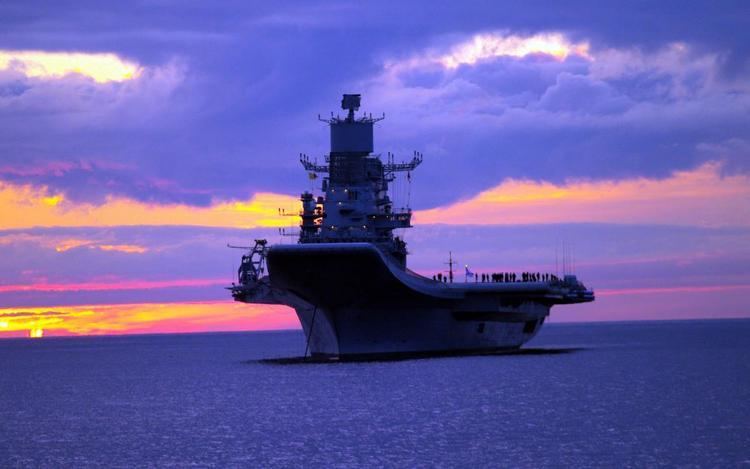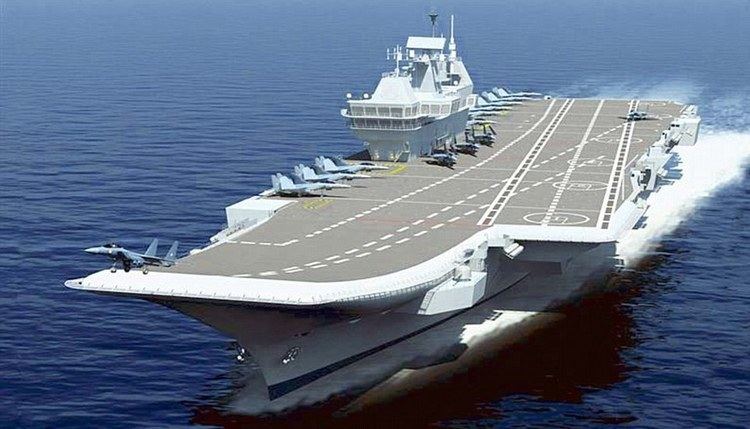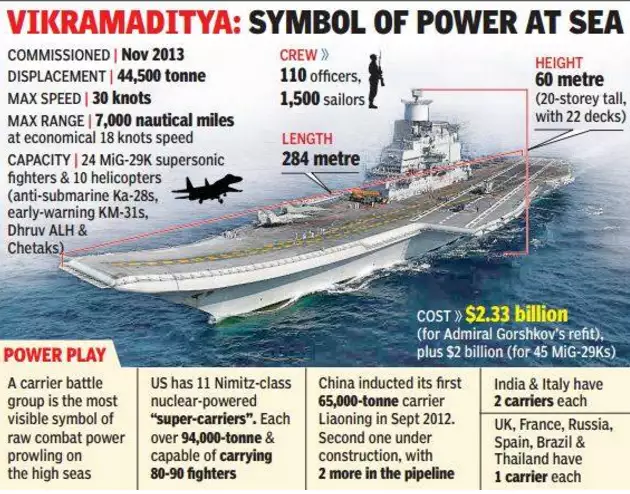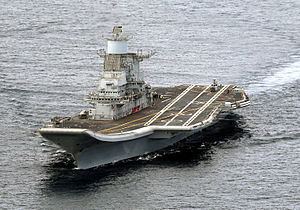Name INS Vikramaditya Cost $2.35 billion Length 273 m Launched 1 April 1982 Endurance 1.5 months | Namesake Vikramāditya Ordered 20 January 2004 Completed 19 April 2012 Construction started 17 February 1978 Draft 10 m Beam 60 m | |
 | ||
Builders | ||
INS Vikramaditya (Sanskrit, Vikramāditya meaning "Brave as the Sun") is a modified Kiev-class aircraft carrier which entered into service with the Indian Navy in 2013. She has been renamed in honour of Vikramaditya, a legendary emperor of Ujjain, India.
Contents
- A modified kiev class aircraft ins vikramaditya
- Purchase
- Refurbishment
- Design
- Structural modifications
- Combat systems
- Air Group
- First sea trials
- Second sea trials
- Surveillance by NATO
- Commissioning
- Service history
- Accidents
- References

Originally built as Baku and commissioned in 1987, the carrier served with the Soviet Navy and later with the Russian Navy (as Admiral Gorshkov) before being decommissioned in 1996. The carrier was purchased by India on 20 January 2004 after years of negotiations at a final price of $2.35 billion. The ship successfully completed her sea trials in July 2013 and aviation trials in September 2013.

She was commissioned on 16 November 2013 at a ceremony held at Severodvinsk, Russia. On 14 June 2014, Prime Minister of India formally inducted INS Vikramaditya into the Indian Navy and dedicated it to the nation.

A modified kiev class aircraft ins vikramaditya
Purchase

Baku entered service in 1987, and was renamed Admiral Gorshkov in 1991, but was deactivated in 1996 because she was too expensive to operate on a post-Cold War budget. This attracted the attention of India, which was looking for a way to expand its carrier aviation capabilities. On 20 January 2004, after years of negotiations, Russia and India signed a deal for the sale of the ship. The ship would be free, while India would pay US$800 million for the upgrade and refit of the ship, as well as an additional US$1 billion for the aircraft and weapons systems. The navy looked at equipping the carrier with the E-2C Hawkeye, but decided not to. In 2009, Northrop Grumman offered the advanced E-2D Hawkeye to the Indian Navy.
The deal also included the purchase of 12 single-seat Mikoyan MiG-29K 'Fulcrum-D' (Product 9.41) and four dual-seat MiG-29KUB aircraft (with an option for 14 more aircraft) at US$1 billion, six Kamov Ka-31 "Helix" reconnaissance and anti-submarine helicopters, torpedo tubes, missile systems and artillery units. Facilities and procedures for training pilots and technical staff, delivery of simulators, spare parts, and establishment maintenance on Indian Navy facilities were also part of the contract.

The upgrade involved stripping all the weaponry and missile launcher tubes from the ship's foredeck to make way for a "short take-off but arrested recovery" (STOBAR) configuration, converting the Gorshkov from a hybrid carrier/cruiser to a pure carrier.
The announced delivery date for INS Vikramaditya was August 2008, which would allow the carrier to enter service just as the Indian Navy's only light carrier INS Viraat retired. While Viraat's retirement had been pushed out to 2010–2012, it underwent a final refit which will enable her to serve through 2016.
The issue with the delays was compounded by ongoing cost overruns, resulting in high-level diplomatic exchanges to get these issues resolved. India finally agreed to pay an additional US$1.2 billion for the project, more than doubling the original cost. However, ongoing delays with the Vikramaditya's delivery schedule, pushed the delivery to 2013. The indigenous Vikrant-class aircraft carrier was delayed by at least a year and was expected to be commissioned at the earliest in 2013 from the proposed 2012.
In July 2008, it was reported that Russia wanted to increase the price by US$2 bn, blaming unexpected cost overruns on the deteriorated condition of the ship and citing a "market price" for a new carrier of US$3–4 bn. India has paid US$400 million as of November 2008. However, Russia even threatened to scrap the deal altogether if India did not pay the amount. In December 2008, government sources in India stated that the Cabinet Committee on Security (CCS) had finally decided in favour of purchasing Admiral Gorshkov as the best option available. The Comptroller and Auditor General of India (CAG) criticised the fact that Vikramaditya would be a second-hand warship with a limited life-span, which would be 60% costlier than a new one, and there was a risk of further delay in its delivery. The Indian Navy Chief of Naval Staff Admiral Sureesh Mehta defended the price for the warship saying, "I can't comment on the CAG. But you all are defence analysts, can you get me an aircraft carrier for less than USD 2 billion? If you can, I am going to sign a cheque right now".
The statement from the Chief of Naval Staff at that time indicated that the final deal could be in excess of US$2 billion. When asked about CAG's finding that the navy had not done its risk analysis before going in for the ship, he was quoted as saying, "I can ensure you that there is no such thing. There is no question, we have been looking at the ship since the late 90s."
On 2 July 2009, Russian President Dmitry Medvedev said that the refit of the carrier should be completed as soon as possible so she could be delivered to India in 2012. On 7 December 2009, Russian sources indicated that final terms had been agreed on, but no delivery date was set. On 8 December 2009, it was reported that India and Russia ended the stalemate over Admiral Gorshkov price deal by agreeing on a price of US$2.2 billion. Moscow was asking for US$2.9 billion for the aircraft carrier, nearly three times the price that was originally agreed between the two sides in 2004. On the other hand, New Delhi wanted the price to be scaled back to US$2.1 billion. Both governments finalised the price of Admiral Gorshkov at US$2.35 billion on 10 March, a day ahead of Russian Prime Minister Vladimir Putin's two-day visit to India.
In April 2010, a scandal over the project emerged when it was announced that a senior Indian Navy officer had probably been blackmailed in order to influence the negotiations over the cost of Admiral Gorshkov to India. Commodore Sukhjinder Singh had been a senior figure supervising the refit of the carrier, working as the principal director for the project. He was discharged from service due to this incident.
Refurbishment
The hull work was completed by 2008 and Vikramaditya was launched on 4 December 2008. Around 99% of the structural work and almost 50% of the cabling work had been completed by June 2010. Almost all of the large equipment, including engines and diesel generators, was installed. A naval MiG-29K prototype aircraft was used to test the deck systems of Vikramaditya in 2010.
All reconfiguration work was completed at Severodvinsk, Russia; however it was delayed by three years due to underestimation of the amount of cabling needed. An expert level discussion on technical and financial matters was held between India and Russia to sort out the issues. The MiG-29K entered operational service with India in February 2010. A compromise was finalised and India was to pay an extra undisclosed amount. Russia was to install new systems instead of repairing the old ones.
On 1 June 2010, the Times of India reported a naval officer saying: "With India earlier this year agreeing to the revised refit cost of $2.33 billion for Gorshkov after three years of bitter wrangling since the earlier agreement inked in January 2004 had earmarked only $974 million for it, Russia has appointed a high-level apex committee to oversee the work on the carrier". The ship was to go for harbour trials by early 2011 to ensure it could be handed over to India by December 2012 or so. Dock trials began on 1 March 2011. The focus of these trials was on the main power generation units and the radio-electronic armament systems, manufactured in India. Indian Navy personnel began training on Vikramaditya in April 2011. On 19 April 2012, it was announced that all internal systems were functioning, and the ship was entirely self-contained. Measurement of the ship's magnetic field and centre of gravity were performed before sea trials began.
Design
As completed, Vikramaditya has a larger full load displacement than when the ship was originally launched in 1982 as Baku. 1,750 out of 2,500 compartments of the ship were re-fabricated, and extensive re-cabling was done to support new radars and sensors. The elevators were upgraded, and two restraining stands were fitted, allowing combat aircraft to reach full power before making a ski jump-assisted short take-off. Three arresting gears were fitted on the aft part of the angled deck, and navigation and carrier-landing aids were added to support fixed-wing "short take-off but arrested recovery" (STOBAR) operations.
Structural modifications
The major modifications were to allow Admiral Gorshkov to operate as a STOBAR aircraft carrier in Indian service, as opposed to the STOVL configuration the ship was built as. This involved removal of all the armament, including the P-500 Bazalt cruise missile launchers and the four Antey Kinzhal surface-to-air missile bins fitted on ship's bow, to make way for a 14.3°, full-width ski-jump. The 20-ton capacity aircraft lift beside the ship's island superstructure was unchanged, but the aft lift was enlarged and its lift capacity increased to 30 tons. For STOBAR operations, three 30 m arrestor wires and three restraining gears on the stern of the angled deck were fitted. Sponsons were installed to increase the area of the flight deck, to allow the ski-jump to be fitted, for strengthening of arresting gear and runway area, and to lengthen the after end, which allowed an increase to the length of the landing strip aft of the arresting gear. 234 new hull sections were installed to achieve the desired shape, and the total steel added to carry out these modifications amounted to 2500 tons.
The superstructure profile was designed to accommodate the fixed phased array scanners of the Soviet Navy's Mars-Passat 3D air search radar system, along with extensive command and control facilities to conduct an aerial campaign. Extensive revamp of sensors was carried out, with long range air-surveillance radars and advanced electronic warfare suites fitted, which enable the maintenance of a surveillance bubble of over 500 km around the ship. An aft mast was installed to accommodate various communication antennae. These changes needed 2,300 km of new cables, and 3,000 km of new pipes.
The eight original boilers were replaced by new generation, high-pressure boilers, converted to take diesel fuel utilising LSHSD instead of furnace fuel oil, each providing a steam capacity of 100 tonnes per hour. The new boilers are highly efficient and have high levels of automation. They power four propellers in four shaft configuration, producing a total thrust of 180,000 horsepower (134,226 kW) at the shaft, providing a top speed of over 30 knots. Six turbo alternators and six diesel alternators generate 18 MW of electricity to power various equipment. Modern oil-water separators as well as a sewage treatment plant were incorporated to meet international standards. Six new Italian Wärtsilä 1.5 MW diesel generators, a Global Marine communications system, Sperry Bridgemaster navigation radar, a new telephone exchange, new data link and an IFF Mk XI system were added. Hotel services were improved with the addition of two reverse osmosis plants producing 400 tons of fresh water per day, as well as updated refrigeration and air conditioning. A new galley was installed together with improved domestic services and accommodation for 10 female officers.
Combat systems
The combat systems on board the carrier are controlled by LESORUB-E, the computer-aided action information system. It gathers data from the ship’s sensors and data links and creates comprehensive situation awareness. The CCS Mk II communication complex is installed for external communications and the Link II tactical data system enables integration into the Indian Navy’s network-centric operations. Modern launch and recovery systems are installed for handling different aircraft – the LUNA landing system for MiG-29Ks and the DAPS Landing system for Sea Harriers. The Resistor-E automated air-traffic control system has been installed, which provides assistance during approach, landing and short range navigation down to a distance of 30 metres short of flight deck to the pilots. Along with various other sub-systems, it provides navigation and flight data to ship-borne aircraft operating at long distances from the carrier.
When delivered, Vikramaditya had yet to be fitted with any on-board armament, leaving her dependent on her battle group for self-defence. This was rectified during the ship's short refit of April–June 2015, when she was fitted with four license-built AK-630 CIWS, and a Barak 1 SAM system stripped from the decommissioned INS Godavari. During the ship's first scheduled major refit in 2017, the Barak 1 system will be replaced with the newly developed Barak 8 long-range air-defence system (LR-SAM), which is currently being tested. It is launched from vertical launch cells, and has an operational range of 0.5–100 km The carrier will carry up to 48 missiles.
The official expected life span of the ship is 40 years, and is unlikely to require any major repair work for at least a decade. Over 70% of the ship and her equipment is new and the remainder has been refurbished. Sevmash Shipyard, which upgraded the carrier, will provide warranty servicing including maintenance for the next 20 years.
Air Group
Vikramaditya has been designed as a STOBAR carrier capable of operating both conventional fixed-wing aircraft and helicopters, with up to 34 aircraft capable of being accommodated. Its primary embarked aircraft type is the Mikoyan MiG-29K, a navalised version of the Mikoyan MiG-29M. The MiG-29K is an advanced, all weather multi-role fighter capable of undertaking both the fleet air defence, low level strike and anti-shipping roles. The primary ASW platform is the venerable Westland Sea King, while AEW is undertaken by the Kamov Ka-31. Carriage ranges given for the ship seem to converge around 16–24 MiG-29K and 10 Kamov Ka-31 or Dhruv helicopters; however Vikramaditya is not capable of operating fixed-wing AEW aircraft owing to her configuration as a STOBAR carrier. Utility and plane guard duties are undertaken by the HAL Chetak (or HAL Dhruv).
First sea trials
Russia was scheduled to hand over Vikramaditya to India on 4 December 2012, with sea trials scheduled to begin on 29 May 2012. The sea trials in fact began on 8 June. The ship sailed out for pre-delivery trials from the berth of the Sevmash shipyard in Russia's northern city of Severodvinsk. These trials were to include landing and take-off of fighter jets from the deck of the carrier.
On 17 September 2012, malfunctions were detected during trials. According to official report, seven out of eight steam boilers of the propulsion machinery were out of order. Due to this, the deadline of the hand over this ship to the Indian Navy was postponed again until October 2013. Later investigation has determined that the cause for the engine failure was due to poor workmanship and supervision. The Gorshkov and other ships of the 1143.4 class had a history of multiple boiler failures, however Russian shipbuilders claimed that the source of the problem was the low-grade Chinese-made fire-bricks that were used in the boiler insulation instead of asbestos.
Second sea trials
On 3 July 2013, Igor Sevastyanov, deputy head of Russia's state arms exporter Rosoboronexport, announced that the warship had departed for sea trials with a mix of Russian and Indian crew. On 28 July 2013, it was reported that Vikramaditya had successfully completed her sea trials and was able to reach her maximum speed of 32 knots. She then proceeded to the White Sea for aviation trials, which were carried out by Russia's Northern Fleet aviation and completed in September 2013. Aircraft and helicopters flew around and over the ship to check the performance of its radar, air defence, communication and control systems, and MiG specialists praised the ski-jump ramp.
The sea trials lasted three months, and the ship demonstrated excellent seaworthiness and manoeuvrability. The carrier’s electronic warfare and jamming capability was demonstrated when Sukhoi-33s, Kamovs, MiG-29s and A-50 early warning aircraft failed to "paint" the carrier using their radars, whereas the incoming aircraft were detected by the ship at a distance of 350–400 km. In total, the ship sailed for 19,500 miles during both the trials, controlled 778 aircraft and helicopter flights, and conducted 88 landings by Russian pilots. During the second sea trial, it sailed for 8,600 miles, of which 1,700 miles were under the command of the ship's Indian captain Commodore Suraj Berry.
Surveillance by NATO
When the trials were ongoing, a Norwegian P-3 Orion aircraft observed Vikramaditya. While in international waters, it flew close to the ship to take photographs, and also dropped sonobuoys to record the ship's acoustic signature. The Norwegian aircraft left the area when a Russian MiG-29 arrived. A Norwegian ship was also seen to observe Vikramaditya.
Commissioning
She was formally commissioned on 16 November 2013 at a ceremony held at Severodvinsk, Russia. The ceremony was attended by Indian defence minister A K Antony and the Russian deputy prime minister Dmitry Rogozin. The ship is now patrolling the Indian ocean.
Service history
After commissioning, the carrier began a continuous 26-day journey of 10,212 nautical miles to its home-port at INS Kadamba, Karwar, from Severodvinsk on 27 November 2013, with a short stopover in Lisbon. It was under the command of Commodore Suraj Berry, her first Indian captain. Apart from her Indian crew, she also carried 177 Russian specialists from Sevmash, who would remain on board for one year, as part of the 20-year post-warranty services contract with the shipyard. During the journey, it encountered a storm in the Barents Sea where she linked up with her escorts frigate INS Trikand and fleet tanker INS Deepak. The group was escorted by the Royal Navy frigate HMS Monmouth while passing through the English Channel, and was joined by destroyer INS Delhi near Gibraltar. The flotilla sailed in the Mediterranean sea, crossed the Suez Canal and entered the Arabian Sea near the Gulf of Aden on 1 January 2014. It was received nearly 1,200 nautical miles (2,200 km) away from Indian shores by a large flotilla of the Western fleet, which was composed of the aircraft carrier INS Viraat, two Delhi-class destroyers, three Talwar-class frigates, the frigate INS Godavari, and a couple of offshore patrol vessels including INS Subhadra. The event was significant as the Indian Navy was operating two aircraft carriers simultaneously for the first time in 20 years. After conducting basic sea exercises with the fleet, Vikramaditya reached Karwar on 7 January 2014.
Navy pilots of INAS 303 "Black Panthers" operating the MiG-29K practised carrier operations at the Shore Based Test Facility (SBTF) in INS Hansa, Dabolim, Vasco-da-Gama. The first aircraft piloted by an Indian Navy pilot landed on the carrier on 8 February 2014. Since then, the pilots and air controllers have been certified for operating the MiG-29K fighters from the carrier deck, including night landings. The carrier's air wing will consist of 16 MiG-29Ks including four KUB trainers, six airborne early warning and control (AEW&C) Kamov Ka-31 and Kamov Ka-28 anti-submarine warfare (ASW) helicopters.
In May 2014, the carrier was declared operationally deployed along with its embarked air group comprising MiG-29Ks and had taken part in a war game conducted by the Western Naval Command. On 14 June 2014, Prime Minister of India dedicated the carrier to the country.
On 8 December 2015, Indian Defence-Ministry sources stated that the INS Vikramaditya would receive its first major overhaul in September 2016 as part of the "Make In India" initiative. The state-owned Cochin Shipyards and the Pipavav shipyards will overhaul the carrier once it is in dry dock.
On 21–22 January 2016, Vikramaditya accompanied by INS Mysore made her first overseas port visit when the ship visited Colombo in Sri Lanka, making the first visit of an Indian warship to the city in 30 years, and the first by an aircraft carrier in more than 40 years.
On 15–18 February 2016, Vikramaditya accompanied by two ships, INS Mysore and INS Deepak, made a goodwill visit to Male, Maldives.
In September 2016, Vikramaditya was dry-docked in Kochi for a month-long refit by Cochin Shipyards; the refit was completed in November, a month ahead of schedule.
A State Bank of India ATM was opened onboard INS Vikramaditya on 21 January 2017, making it the first Indian Navy ship to have an ATM.
Accidents
On 10 June 2016, while undergoing a scheduled major refit of INS Vikramaditya, two people were killed by a toxic gas leak that occurred during maintenance work in the Sewage Treatment Plant compartment of INS Vikramaditya at Karwar. Two other people were injured and taken to the naval hospital.
